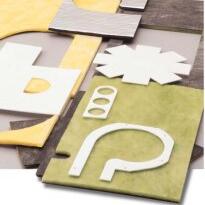Benefits of Prefabricated OEM Fiberglass Insulation

SUCCESS STORIES share actual product applications using the strength of Insul-Fab's capabilities and supplier relationships to solve customer challenges.
The Situation
Recently, an air conditioning equipment manufacturing company in Texas submitted an inquiry for large rolls of OEM grade light-density fiberglass, a 1/2"-2" thick thermal insulation material commonly used in the HVAC and appliance market. The company intended to cut the rolls manually into various shapes for installation into air handling components.
The Solution
As both a distributor and a preferred converter of OEM insulation materials, InsulFab has the benefit of being able to supply fiberglass in rolls and sheets, or pre-cut parts. Since the application was price-sensitive, the customer perceived fabricated parts as more expensive, and wanted to know why a converted solution was more beneficial than buying rolls and cutting the parts in-house.
Raw Materials
Most engineered raw materials such as Johns Manville OEM Fiberglass Insulation and Lydall Thermal Insulation are made in large rolls or sheets. For the raw material supplier, manufacturing and shipping rolls in bulk offers efficiency in production, shipping and SKU management. Fabrication for end use is typically performed by a local converter or the end user themselves. For OEM applications with repeating shapes used in sustained production, there are many benefits to buying pre-cut parts.
Benefits of Fabricated Parts:
- Precision cutting/tight tolerance fit. Insulation fabcricators, like InsulFab, have experience and dedicated equipment for precision converting. By contrast, hand-cut parts vary by the skill level of the craftsman. In most instances, the parts simply do not fit well enough to install, leading to inconsistency in “stuffing” material into place or leaving voids with improper coverage..
- Optimum utilization of roll (preventing scrap and waste). Pre-cut parts can be nested through engineering programs to maximize the yield of the raw material, reducing scrap, which in turn saves on material cost. Hand-cutting can reduce material yield by 30% or more.
- Labor Savings. Manual cutting is usually more inefficient than customers realize. For instance, die-cutting is a high-speed cutting method, and multi-cavity dies can produce a great number of parts with one impression. High-speed water jet cutting allows material to be cut in multiple layers, often five sheets or rolls deep, at extremely fast speeds.
- Smaller packaging. Most rolls and sheets are difficult to unpack, handle and store, leading to potential damage and overuse of storage space. InsulFab neatly packages parts on poly bags of standard part count, for easy handling, storage and counting, which makes forecasting easier. Additionally, most bags are vacuum packed, further reducing their profile and making shelf storage and point-of-use easy
- Value Add. Die-cut or fabricated parts provide additional opportunities for value additions to the material, such as foil/scrim/kraft (FSK) facing lamination, anti-microbial edge treatment, or addition of pressure sensitive adhesives.
Fortunately, in this instance, Insul-Fab was able to demonstrate the value that each of these benefits would bring to the customer. After considering each of these benefits, the customer was persuaded mostly by InsulFab’s ability to save them space and provide an easier inventory count for planning and forecasting purposes. When considering in-house manufacturing, it is always best to at least consider all of the benefits to a converted solution, even if in the end, in-house fabrication remains the best option.
Date/Pub ID: 11/4/2022 SS018
